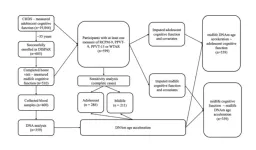(Press-News.org) UNIVERSITY PARK, Pa. — Dairy isn’t the only food that’s good for bone health. Prunes may also protect bone structure and strength in postmenopausal women, according to a new study led by Penn State researchers. The findings, published in Osteoporosis International, suggest that daily prune consumption slows the progression of age-related bone loss and reduces the risk of fracture.
“This is the first randomized controlled trial to look at three-dimensional bone outcomes with respect to bone structure, geometry and estimated strength,” said Mary Jane De Souza, distinguished professor of kinesiology and physiology at Penn State. “In our study we saw that daily prune consumption impacted factors related to fracture risk. That’s clinically invaluable.”
Bones are made of dynamic tissues that are constantly in a process of remodeling. Specialized bone cells remove old bone replacing it with new bone. With age, the scales start to tip, and the body breaks down bone faster than it can build it.
The accelerated loss of bone can lead to osteoporosis, a disease where bone becomes less dense and bone structure changes, making it weaker and at greater risk of fracture. Over 10 million Americans have the condition, according to the Centers for Disease Control and Prevention, and it’s more common in women compared to men and in older adults.
It’s of particular concern among postmenopausal women, the researchers said. Estrogen, a hormone critical for bone health, declines during this life phase and lower levels of estrogen hastens the loss of bone density. While there is medication available to treat osteoporosis, the researchers said that many women who should be taking it aren’t.
Prunes offer a promising alternative, according to De Souza. They contain bioactive compounds like polyphenols that may blunt the inflammatory pathways that lead to bone loss.
Prior studies primarily used dual energy X-ray absorptiometry (DXA) to evaluate 2D bone mass density and to diagnose osteoporosis. But DXA scans can’t distinguish between different types of bone tissue or measure the structural properties of bone, which can serve as a proxy for bone strength and quality, the researchers explained.
“When we look at bone mineral density, we’re looking at how much bone there is, but we also want to know about the quality of the bone. When we look at a three-dimensional picture, we can look at bone structure, geometry and micro-architecture. In other words, it tells us how good the bone is,” De Souza said.
To see whether daily prune consumption influenced bone quality, the research team conducted a 12-month randomized controlled trial with 235 postmenopausal women. Participants were assigned to one of three groups: no prunes; 50 grams, or four to six, prunes daily; or 100 grams, or 10 to 12, prunes daily. Every six months, they were assessed using a peripheral quantitative computed tomography, or pQCT, scan, which allows for cross-sectional imaging to measure 3D bone mass density, bone geometry and bone strength.
Over the course of one year, the researchers found that measures of bone mass density and bone strength at the tibia, or shin bone, all decreased in women in the control group. In contrast, those who ate at least four to six prunes every day maintained bone density and bone strength and preserved bone structure, particularly in cortical bone. While women in both prune groups saw benefit, four to six prunes a day may be the more feasible dose. Women in the 100-gram group dropped out of the study at a higher rate because they got bored of incorporating so many prunes into their daily diet.
“It’s pretty exciting data for a 12-month study,” De Souza said. “We were able to maintain and preserve bone at the weight-bearing, cortical bone of the tibia and the maintenance of cortical bone and bone strength is key to avoiding fracture.”
Prune consumption could also potentially reduce the risk of osteoporosis, De Souza explained, but more research is needed.
With this paper, the research team has built on a suite of studies that investigate the relationship between prunes and bone health. In a prior study with the same cohort of women, the research team demonstrated that daily prunes consumption for a year also preserved total bone mass density at the hip. They’ve also investigated potential mechanisms behind prunes’ bone protective effects, including how prunes influence bacteria in the gut microbiome. De Souza said they hope to continue to expand on these findings in future studies.
Other Penn State authors on the papers include Nancy Williams, professor of kinesiology and physiology, and Janhavi Damani, doctoral student in the integrative and biomedical physiology graduate program in the Huck Institutes of the Life Sciences. Kristen Koltun, who was a doctoral student at Penn State at the time of the research and is currently an assistant professor of sports medicine and nutrition at the University of Pittsburgh, led the study. Co-author Nicole Strock, earned her doctorate at Penn State and is currently a human performance scientist at NASA Johnson Space Center. Connie Weaver, distinguished research professor at San Diego State University; Hang Lee, associate professor of medicine at Harvard Medical School; Connie Rogers, professor of nutritional sciences at the University of Georgia; Mario Ferruzzi, professor of pediatrics at the University of Arkansas for Medical Sciences; and Cindy Nakatsu, professor of agronomy at Purdue University, also contributed to the paper.
Funding from the California Prune Board supported this work.
END
Got prunes? Prunes may preserve bone density and strength in older women
A yearlong randomized controlled trial found that daily prune consumption slowed bone loss connected to osteoporosis
2024-06-25
ELSE PRESS RELEASES FROM THIS DATE:
Associations of childhood, adolescence, and midlife cognitive function with DNA methylation age acceleration in midlife
2024-06-25
“[...] our study brings attention to the potential influence of adolescent crystalized intelligence on age-related DNAm at older age.”
BUFFALO, NY- June 25, 2024 – A new research paper was published in Aging (listed by MEDLINE/PubMed as "Aging (Albany NY)" and "Aging-US" by Web of Science) Volume 16, Issue 11, entitled, “Associations of childhood, adolescence, and midlife cognitive function with DNA methylation age acceleration in midlife.”
Prior studies showed increased age acceleration (AgeAccel) is associated with worse cognitive function among ...
Think you might have COVID? Wait two days to test
2024-06-25
Peek in medicine cabinets across the U.S. and you’ll find stacks of leftover COVID-19 tests.
When symptoms arise, so do questions: When should I test? How accurate is it really? And what should I do if I test positive?
In a paper published June 14 in the journal Science Advances, CU Boulder researchers unveil a new mathematical model to quickly answer such questions, not only for COVID but also for emerging rapid tests for respiratory syncytial virus (RSV), the flu and other infectious diseases.
One key takeaway: Advice can differ ...
Researchers develop new training technique that aims to make AI systems less socially biased
2024-06-25
CORVALLIS, Ore. – An Oregon State University doctoral student and researchers at Adobe have created a new, cost-effective training technique for artificial intelligence systems that aims to make them less socially biased.
Eric Slyman of the OSU College of Engineering and the Adobe researchers call the novel method FairDeDup, an abbreviation for fair deduplication. Deduplication means removing redundant information from the data used to train AI systems, which lowers the high computing costs of the training.
Datasets gleaned from the internet often contain biases present in society, the researchers said. When those biases are codified in trained AI models, they can serve to perpetuate ...
Backward walking speed reserve assessment offers improved clinical screening for risks and decline in MS patients
2024-06-25
DETROIT — Wayne State University postdoctoral research fellows Patrick Monaghan, Ph.D., and Michael VanNostrand, Ph.D., along with Nora E. Fritz, Ph.D., PT, DPT, NCS, director of the Neuroimaging and Neurorehabilitation Lab and associate professor of physical therapy in the Department of Health Care Sciences in WSU’s Eugene Applebaum College of Pharmacy and Health Sciences, recently published a study on mobility assessments in the journal, Multiple Sclerosis and Related Disorders.
The study, “Backwards walking speed reserve in persons ...
Clinical trial evaluates economic impact of changing how healthcare is delivered to older people in the emergency department
2024-06-25
The evaluation of the OPTI-MEND trial demonstrates that investing in an additional dedicated professional team to the already existing ED care increases patients’ quality of life and will save, on average per person, a staggering €6,128.
Crowding in emergency departments (EDs) is a growing problem in Ireland and internationally and, coupled with long waiting times, affects healthcare outcomes and patient satisfaction. A new study from researchers at Trinity College Dublin and University of Limerick examined the economic impact of adding a specific, appropriate, and dedicated team of professionals to the care already available ...
Uncovering the drivers of a million-year-old glacial transition
2024-06-25
The climate modeling community has been particularly vexed by the glacial/interglacial cycles of the past three million years, when the Northern Hemisphere oscillated between times with and without large ice sheets.
From about 1.25 million to 750,000 years ago—in the Pleistocene epoch—a change in glacial cycles called the Mid-Pleistocene Transition (MPT) occurred. During this time, glacial/interglacial cycles shifted from occurring every 41,000 years to every 100,000 years, with an increase in the amplitude and asymmetry of the cycles. Scientists are working to understand why these changes happened, considering that insolation forcing—variation ...
Surprising vortex behind new solar cell and lighting materials
2024-06-25
Metal-halide perovskites have quickly advanced in the last decade since their discovery as a semiconductor that outshines silicon in its conversion of light into electric current.
Simulations on TACC's Frontera and Lonestar6 supercomputers have revealed surprising vortex structures in quasiparticles of electrons and atoms, called polarons, which contribute to generating electricity from sunlight.
This new discovery can help scientists develop new solar cells and LED lighting. This type of lighting is hailed as eco-friendly, sustainable technology ...
Should you eat more dietary fiber? New study says it depends.
2024-06-25
ITHACA, N.Y. -- Nutritionists generally advise everyone to eat more dietary fiber, but a new Cornell University study suggests that its effects on health can vary from person to person. The findings indicate that recommendations should be tailored to each individual’s gut microbiome.
The study, published in Gut Microbes, focused on resistant starch, a category of dietary fiber found in such foods as bread, cereals, green bananas, whole-grain pasta, brown rice and potatoes.
The researchers identified ...
Researchers evaluate the benefit of dual therapy for children at risk for spinal muscular atrophy
2024-06-25
In a first-of-its-kind study, researchers compared the efficacy of preventative therapy for spinal muscular atrophy (SMA) between two well-matched study groups, using either gene therapy (onasemnogene abeparvovec) alone or in combination with risdiplam (oral medication) or nusinersen (intrathecal injection) administered before apparent signs of disease emerged. The study included presymptomatic infants with two or three copies of SMN2 at risk for developing SMA type 1 or 2, respectively. SMA is a devastating ...
Analysis suggests 2021 Texas abortion ban resulted in increase in infant deaths in state in year after law went into effect
2024-06-25
A study led by Johns Hopkins Bloomberg School of Public Health researchers estimates that infant deaths in Texas increased more than expected in the year following the state’s 2021 ban on abortion in early pregnancy, especially among infants with congenital anomalies.
The Texas law prohibiting abortions after a fetal heartbeat could be detected—as early as five or six weeks—went into effect September 1, 2021. At the time, the law—Senate Bill 8, or S.B. 8—was the most stringent state abortion law in the country. It did not allow exemptions for congenital ...
LAST 30 PRESS RELEASES:
Scientists trace microplastics in fertilizer from fields to the beach
The Lancet Obstetrics, Gynecology, & Women’s Health: Taking paracetamol during pregnancy does not increase risk of autism, ADHD or intellectual disabilities, confirms new gold-standard evidence review
Taking paracetamol during pregnancy does not increase risk of autism, ADHD or intellectual disabilities
Harm reduction vending machines in New York State expand access to overdose treatment and drug test strips, UB studies confirm
University of Phoenix releases white paper on Credit for Prior Learning as a catalyst for internal mobility and retention
Canada losing track of salmon health as climate and industrial threats mount
Molecular sieve-confined Pt-FeOx catalysts achieve highly efficient reversible hydrogen cycle of methylcyclohexane-toluene
Investment in farm productivity tools key to reducing greenhouse gas
New review highlights electrochemical pathways to recover uranium from wastewater and seawater
Hidden pollutants in shale gas development raise environmental concerns, new review finds
Discarded cigarette butts transformed into high performance energy storage materials
Researchers highlight role of alternative RNA splicing in schizophrenia
NTU Singapore scientists find new way to disarm antibiotic-resistant bacteria and restore healing in chronic wounds
Research suggests nationwide racial bias in media reporting on gun violence
Revealing the cell’s nanocourier at work
Health impacts of nursing home staffing
Public views about opioid overdose and people with opioid use disorder
Age-related changes in sperm DNA may play a role in autism risk
Ambitious model fails to explain near-death experiences, experts say
Multifaceted effects of inward foreign direct investment on new venture creation
Exploring mutations that spontaneously switch on a key brain cell receptor
Two-step genome editing enables the creation of full-length humanized mouse models
Pusan National University researchers develop light-activated tissue adhesive patch for rapid, watertight neurosurgical sealing
Study finds so-called super agers tend to have at least two key genetic advantages
Brain stimulation device cleared for ADHD in the US is overall safe but ineffective
Scientists discover natural ‘brake’ that could stop harmful inflammation
Tougher solid electrolyte advances long-sought lithium metal batteries
Experts provide policy roadmap to reduce dementia risk
New 3D imaging system could address limitations of MRI, CT and ultrasound
First-in-human drug trial lowers high blood fats
[Press-News.org] Got prunes? Prunes may preserve bone density and strength in older womenA yearlong randomized controlled trial found that daily prune consumption slowed bone loss connected to osteoporosis



